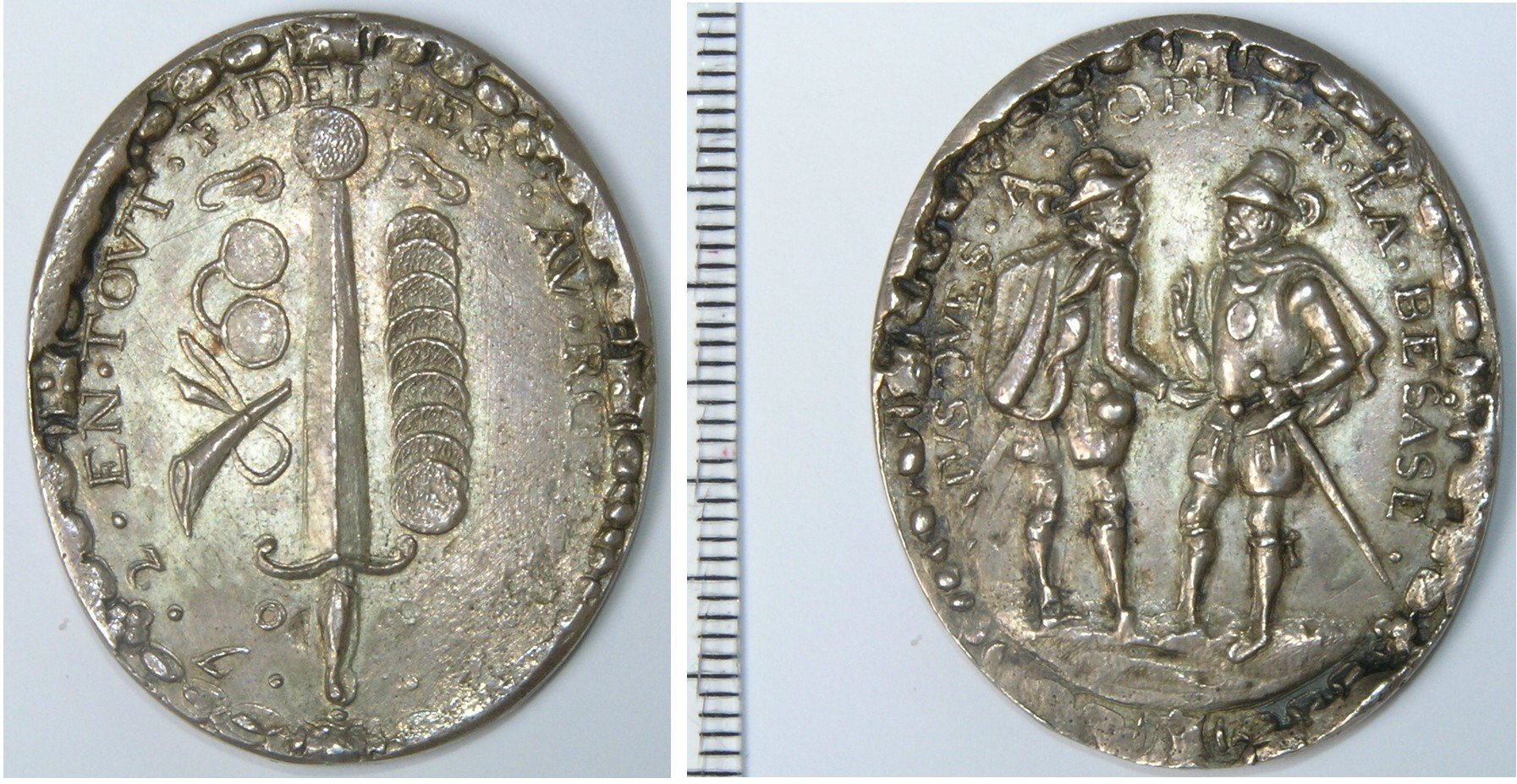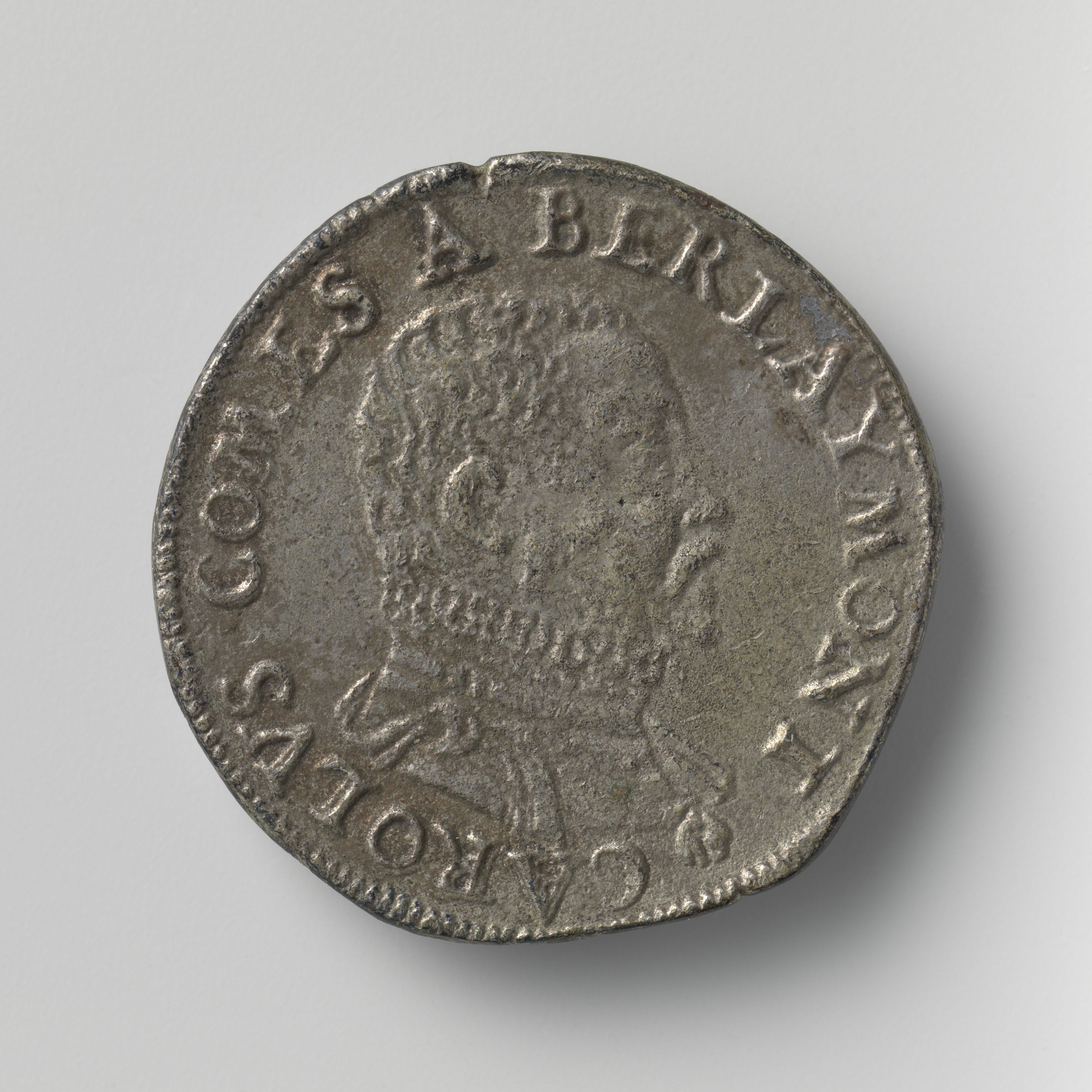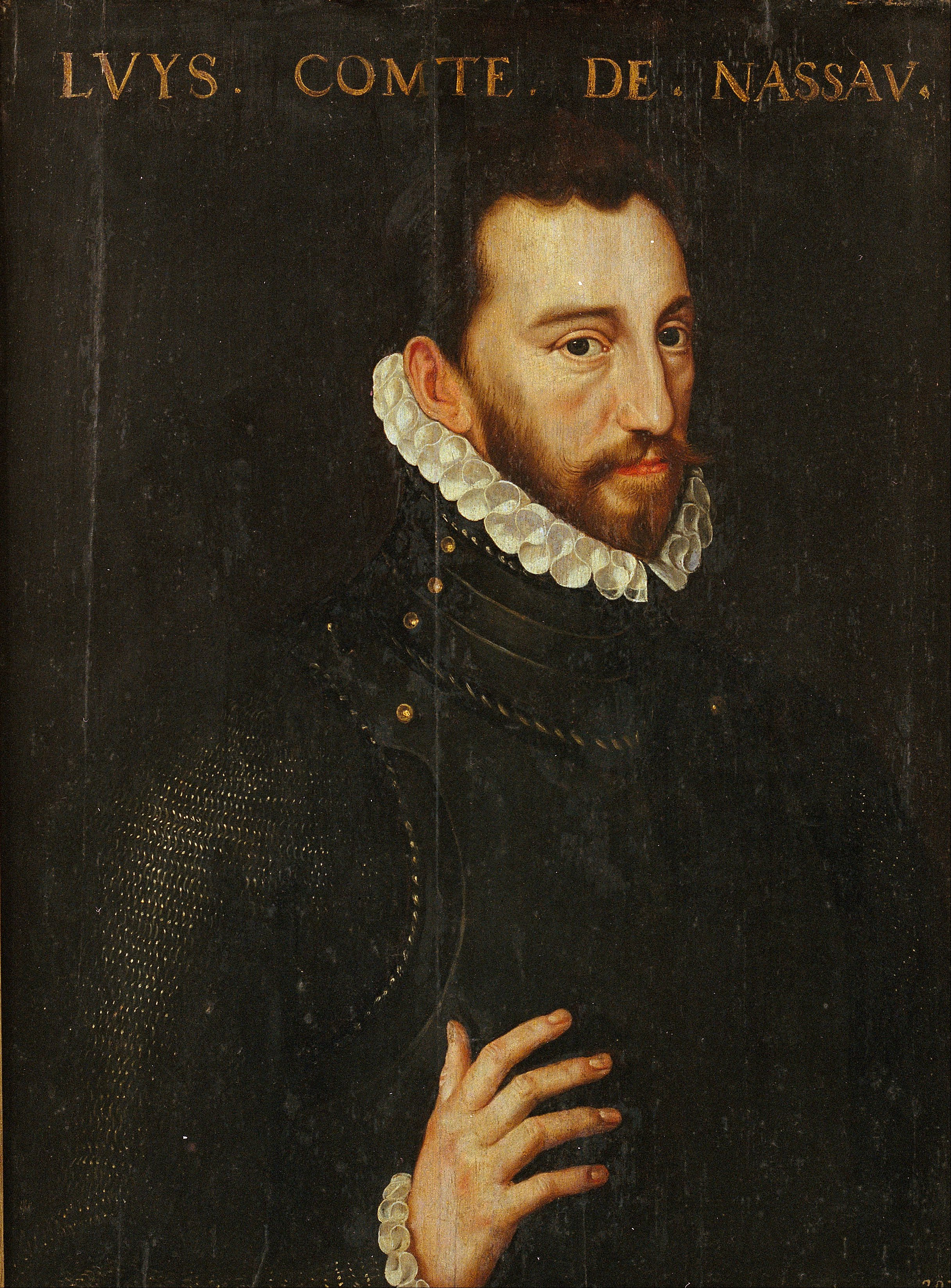|
Geuzen
Geuzen (; ; french: Les Gueux) was a name assumed by the confederacy of Calvinist Dutch nobles, who from 1566 opposed Spanish rule in the Netherlands. The most successful group of them operated at sea, and so were called Watergeuzen (; ; french: links=no, Gueux de mer). In the Eighty Years' War, the Capture of Brielle by the Watergeuzen in 1572 provided the first foothold on land for the rebels, who would conquer the northern Netherlands and establish an independent Dutch Republic. They can be considered either as privateers or pirates, depending on the circumstances or motivations. Origin of the name The leaders of the nobles who signed a solemn league known as the Compromise of Nobles, by which they bound themselves to assist in defending the rights and liberties of the Netherlands against the civil and religious despotism of Philip II of Spain, were Louis of Nassau and Hendrick van Brederode. On 5 April 1566, permission was obtained for the confederates to present a peti ... [...More Info...] [...Related Items...] OR: [Wikipedia] [Google] [Baidu] |
Geuzen Medals
Geuzen medals, Beggars or Sea Beggars medals were minted early in the Dutch Revolt and during the first half of the 16th-century Eighty Years' War. During that period, many medals, tokens and jetons with a political message were minted. The earliest Geuzen medals (or tokens) date from the mid-16th century to 1577. In Dutch, ''geus'' (plural ''geuzen'') is a familiar term for the people who revolted in the 16th century against the Spanish king Philip II. The revolt began with the nobility, spreading to the gentry and the common prole. Years later, when war broke out, the title ''geus'' (or ''watergeus'') was given to the irregular force of rebels fighting and living in the estuaries of large rivers; the name ''bosgeus'' ("forest ''geus''") was given to those living in the woods. ''Geus'' is derived from the French word for beggar, hence the translation of ''watergeus'' as "sea beggar". The term "sea beggar" is also used for a land-bound ''geus''. Background The Holy Roman Em ... [...More Info...] [...Related Items...] OR: [Wikipedia] [Google] [Baidu] |
Compromise Of Nobles
The Compromise of Nobles ( nl, Eedverbond der Edelen; french: Compromis des Nobles) was a covenant of members of the nobility in the Habsburg Netherlands who came together to submit a petition to the Regent Margaret of Parma on 5 April 1566, with the objective of obtaining a moderation of the ''placards'' against heresy in the Netherlands. This petition played a crucial role in the events leading up to the Dutch Revolt and the Eighty Years' War. Background The ruler of the Habsburg Netherlands, a conglomerate of duchies and counties and lesser fiefs, was Philip II of Spain. He had appointed his half-sister Margaret of Parma as his Regent. She ruled with the assistance of a Council of State which included a number of the high nobility of the country, like the Prince of Orange, Egmont, Horne, Aerschot and Noircarmes. From time to time (whenever she needed money) she convened the States-General of the Netherlands in which the several estates of the provinces were represente ... [...More Info...] [...Related Items...] OR: [Wikipedia] [Google] [Baidu] |
Charles De Berlaymont
Charles de Berlaymont (1510 in Berlaimont? – 1578 in Namur?) was a leading nobleman in the Low Countries in the 16th century. He was an important counselor of Margaret of Parma, Grand Huntsman of Brabant and generally sided with Spanish politics in the early years of the Eighty Years War. Biography He was the son of Michèl de Berlaymont and Maria de Berault. He was lord of Floyon and Haultpenne, and baron of Hierges. In 1553, he became stadtholder of Namur. Berlaymont was knight of the Order of the Golden Fleece, senior hunting master of Brabant, Flanders and Namur, member of the Council of State, hereditary chamberlain of finances and bailiff of the county of Namur. In 1567, he became a member of the much-dreaded Council of Troubles. In 1574, his home territory Berlaimont was elevated to the status of a county. In 1577, Berlaymont was one of the signees of the Union of Brussels, which he immediately repudiated. He is known for his famous comment on the Compromise of Nob ... [...More Info...] [...Related Items...] OR: [Wikipedia] [Google] [Baidu] |
Capture Of Brielle
The Capture of Brielle by the ''Geuzen, Watergeuzen'', on 1 April 1572 marked a turning point in the uprising of the Seventeen Provinces, Low Countries against Spain in the Eighty Years' War. Militarily the success was minor as the port of Brielle was undefended, but it provided the first foothold on land for the rebels at a time when the rebellion was all but crushed, and it offered the sign for a new revolt throughout the Netherlands which led to the formation of the Dutch Republic. Overview The ''Watergeuzen'' were led by William van der Marck, Lord of Lumey,Elliot, p. 139 and by two of his captains, Willem Bloys van Treslong and Lenaert Jansz de Graeff. After they were expelled from England by Elizabeth I, they needed a place to shelter their 25 ships. As they sailed towards Brielle, they were surprised to find out that the Spanish garrison had left in order to deal with trouble in Utrecht (city), Utrecht. On the evening of April 1, the 600 men sacked the undefended port. As ... [...More Info...] [...Related Items...] OR: [Wikipedia] [Google] [Baidu] |
William De La Marck, Lord Of Lumey
William II de la Marck (Lummen, 1542 – Bishopric of Liège, 1 May 1578) (Dutch: ''Willem II van der Marck'') was the Dutch Lord of Lumey and initially admiral of the Watergeuzen, the so-called 'sea beggars' who fought in the Eighty Years' War (1568–1648), together with among others William the Silent, Prince of Orange-Nassau. He was the great-grandson of an equally notorious character, baron William de la Marck, nicknamed the "wild boar of the Ardennes". On 1 April 1572 – the day of the Capture of Brielle – the Sea Beggars were led by De la Marck, and by two of his captains, Willem Bloys van Treslong and Lenaert Jansz de Graeff. After they were expelled from England by Elizabeth I, they needed a place to shelter their 25 ships.Elliot, p. 139 As they sailed towards Brill, they were surprised to find out that the Spanish garrison had left in order to deal with trouble in Utrecht. On the evening of 1 April, the 600 men sacked the undefended port.Elliott, p. 140 A Ca ... [...More Info...] [...Related Items...] OR: [Wikipedia] [Google] [Baidu] |
Margaret Of Parma
Margaret of Parma (; 5 July 1522 – 18 January 1586) was Governor of the Netherlands from 1559 to 1567 and from 1578 to 1582. She was the illegitimate daughter of the then 22-year-old Holy Roman Emperor Charles V and Johanna Maria van der Gheynst. She was a Duchess of Florence and a Duchess of Parma and Piacenza by her two marriages. Biography Margaret's mother, Johanna Maria van der Gheynst, a servant of Count Charles de Lalaing, Seigneur de Montigny, was a Fleming. Margaret was brought up in Mechelen, under the supervision of two powerful Spanish and Austrian Habsburg Imperial family relatives, her great-aunt, the Archduchess Margaret of Austria, and her aunt Mary of Austria, who were successive governors of the Netherlands from 1507 to 1530 and from 1530 to 1555, respectively. Her early life followed a strict routine set forth by her father, Charles V, who used his daughter as part of his plans to secure his empire. In 1527, the year she turned five, she became ... [...More Info...] [...Related Items...] OR: [Wikipedia] [Google] [Baidu] |
Louis Of Nassau
Louis of Nassau (Dutch: Lodewijk van Nassau, January 10, 1538 – April 14, 1574) was the third son of William I, Count of Nassau-Siegen and Juliana of Stolberg, and the younger brother of Prince William of Orange Nassau. Louis was a key figure in the revolt of the Netherlands against Spain and a strongly convinced Calvinist, unlike his brother William, whom he helped in various ways, including by arranging the marriage between him and his second wife Anna of Saxony. In 1569 William appointed him governor of the principality of Orange, giving him an indisputable position in French politics. The Compromise In 1566 he was one of the leaders of the league of lesser nobles who signed the "Compromis des Nobles". The Compromise was an open letter, in the form of a petition, to King Philip II of Spain stating that he should withdraw the Inquisition in the Netherlands. On April 5, 1566, with the following of two hundred horsemen, the Compromise was presented to the regent Ma ... [...More Info...] [...Related Items...] OR: [Wikipedia] [Google] [Baidu] |
William I Of Orange
William the Silent (24 April 153310 July 1584), also known as William the Taciturn (translated from nl, Willem de Zwijger), or, more commonly in the Netherlands, William of Orange ( nl, Willem van Oranje), was the main leader of the Dutch Revolt against the Spanish Habsburgs that set off the Eighty Years' War (1568–1648) and resulted in the formal independence of the United Provinces in 1648. Born into the House of Nassau, he became Prince of Orange in 1544 and is thereby the founder of the Orange-Nassau branch and the ancestor of the monarchy of the Netherlands. In the Netherlands, he is also known as Father of the Fatherland (''Pater Patriae'') ( nl, Vader des Vaderlands). A wealthy nobleman, William originally served the Habsburgs as a member of the court of Margaret of Parma, governor of the Spanish Netherlands. Unhappy with the centralisation of political power away from the local estates and with the Spanish persecution of Dutch Protestants, William joined the Dutch ... [...More Info...] [...Related Items...] OR: [Wikipedia] [Google] [Baidu] |
Brielle
Brielle (), also called Den Briel in Dutch and Brill in English, is a town, municipality and historic seaport in the western Netherlands, in the province of South Holland, on the north side of the island of Voorne-Putten, at the mouth of the New Maas. The municipality covers an area of of which is water. In its population was . The municipality of Brielle also includes the communities Vierpolders and Zwartewaal. History Brielle is a very old, fortified city. Its name is derived from the Celtic word ''brogilo'' (meaning "closed area" or "hunting grounds"). The oldest writings about Brielle indicate that the current location is the "new" Brielle. ''Den ouden Briel'' (Old Brill) must have been situated somewhere else on the Voorne-Putten Island. It received City rights in the Netherlands, city rights in 1306. The city was for a long time the seat of the Count of Voorne, until this fiefdom was added to Holland in 1371. It had its own harbour and traded with the countries around t ... [...More Info...] [...Related Items...] OR: [Wikipedia] [Google] [Baidu] |
Willem Bloys Van Treslong
Willem Bloys van Treslong (1529 – 17 July 1594) was a nobleman from the Southern Netherlands and military leader during the Dutch war of Independence. He was best known as one of the leaders of the Sea Beggars who captured Den Briel on 1 April 1572. Biography The family Bloys van Treslong had lands in Flanders, Hainaut and Holland; they are descended from John of Beaumont. His was the bailiff of Voorne. Bloys van Treslong left Spanish service in 1558, and in 1567, joined other high nobles of the Netherlands in refusing to pledge allegiance to Margaret of Parma, the governor of the Netherlands, and was part of the Compromise of Nobles. He fought in the battle of Heiligerlee in 1568. In 1571, William the Silent provided him with letters of marque and equipped two ships to join the Sea Beggars. In March 1572, Bloys van Treslong's ships were trapped by ice at Wieringen and are attacked by four Spanish companies of infantry. Bloys escaped from the Spaniards but lost his sw ... [...More Info...] [...Related Items...] OR: [Wikipedia] [Google] [Baidu] |
Reappropriation
In linguistics, reappropriation, reclamation, or resignification is the cultural process by which a group reclaims words or artifacts that were previously used in a way disparaging of that group. It is a specific form of a semantic change (i.e. change in a word's meaning). Linguistic reclamation can have wider implications in the fields of discourse and has been described in terms of personal or sociopolitical empowerment. Characteristics A ''reclaimed'' or ''reappropriated'' word is a word that was at one time pejorative but has been brought back into acceptable usage, usually starting within its original target, i.e. the communities that were pejoratively described by that word, and later spreading to the general populace as well. Some of the terms being reclaimed have originated as non-pejorative terms that over time became pejorative. Reclaiming them can be seen as restoring their original intent. This, however, does not apply to all such words as some were used in a der ... [...More Info...] [...Related Items...] OR: [Wikipedia] [Google] [Baidu] |
Huguenot
The Huguenots ( , also , ) were a religious group of French Protestants who held to the Reformed, or Calvinist, tradition of Protestantism. The term, which may be derived from the name of a Swiss political leader, the Genevan burgomaster Bezanson Hugues (1491–1532?), was in common use by the mid-16th century. ''Huguenot'' was frequently used in reference to those of the Reformed Church of France from the time of the Protestant Reformation. By contrast, the Protestant populations of eastern France, in Alsace, Moselle, and Montbéliard, were mainly Lutherans. In his ''Encyclopedia of Protestantism'', Hans Hillerbrand wrote that on the eve of the St. Bartholomew's Day massacre in 1572, the Huguenot community made up as much as 10% of the French population. By 1600, it had declined to 7–8%, and was reduced further late in the century after the return of persecution under Louis XIV, who instituted the '' dragonnades'' to forcibly convert Protestants, and then finally rev ... [...More Info...] [...Related Items...] OR: [Wikipedia] [Google] [Baidu] |








